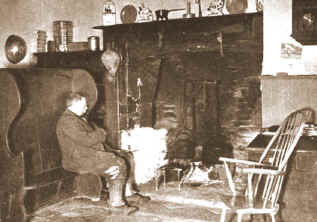Living and Working
 Until the middle of the 19th century, many country people in
Cornwall had scarcely ever seen coal; their fuel consisting either of wood, or of furze
and turf cut from the surrounding moors. The kitchens at that time had no cooking ranges
like those of today; the fireplace consisted of a great opening, resembling a cave, in one
of theouter walls of the room. This cavity was generally five or six feet wide and about
the same height, with its side-posts and supporting piece across the top constructed of
large stone slabs. The fire burned in the centre of these hearths, directly on its flat
stone foundation, and there were no bars to keep it in as in an ordinary grate. In many
households, the fire was never allowed to go out by day or night, and one turf fire in the
parish of Lanlivery was apparently kept alight continuously for more than 60 years. The
same fire which kept the family warm and comfortable in the evenings after work, also
served to cook their food.
Until the middle of the 19th century, many country people in
Cornwall had scarcely ever seen coal; their fuel consisting either of wood, or of furze
and turf cut from the surrounding moors. The kitchens at that time had no cooking ranges
like those of today; the fireplace consisted of a great opening, resembling a cave, in one
of theouter walls of the room. This cavity was generally five or six feet wide and about
the same height, with its side-posts and supporting piece across the top constructed of
large stone slabs. The fire burned in the centre of these hearths, directly on its flat
stone foundation, and there were no bars to keep it in as in an ordinary grate. In many
households, the fire was never allowed to go out by day or night, and one turf fire in the
parish of Lanlivery was apparently kept alight continuously for more than 60 years. The
same fire which kept the family warm and comfortable in the evenings after work, also
served to cook their food.
During the last century, due to the Corn Laws, which prevented the importation of foreign grain, the price of flour was very high, and poor people scarcely ever saw a loaf made from wheat. Their bread being usually made from dark and coarse barley. Most cottagers kept a pig, which provided them with practically the only meat they ever tasted. When circumstances allowed, half the carcass would be eaten fresh, and the remainder "cured" or preserved, although here again, the poor were hampered by the high price of salt.
Butter and milk were equally scarce at that time, whilst jam and sweets were unheard of. For the most part, the poor lived on boiled potatoes and pilchards. After a big catch, these fish were sometimes sold as cheaply as sixpence a hundred, and every household in those days kept an earthenware pot in which a stock of pilchards was placed in salt to last throug the winter. People who could afford to do so would often lay in as many as a thousand fish at a time.
Broth or soup made from vegetables and a few meat bones, was looked upon as the best dinner of the week, and therefore reserved for Sundays. On other days, the working-man's dinner usually consisted of a slice or two of bread and treacle, or at best a barley pasty containing only potatoes and turnips. The miners often preferred a "hoggan": a solid lump of flour mixed with water, and baked without any leavening, and occasionally a little bit of green pork embedded in its centre.
Although their food was coarse and scanty, men of those days were expected to work hard. Many miners had to walk six miles or more to and from work every day, and than put in eight hours slogging toil underground. Farmers, in the busy season, would wheel three hundred barrow-loads of manure onto the fields in one day, or worked at harvest-time from dawn to dusk, bent double over their sickles. Fishermen would be out at sea for days and nights on end, in open boats, facing the wind and rain.
Nor did the women were less hard in their own way. Living in a tiny cottage, with perhaps four or five men and boys, some of whom might be working at night and coming home to sleep during the day. Meals had to be got prepared at all hours, and there was the baking, sewing, and washing to be done, besides a hundred-and-one other things requiring attention.